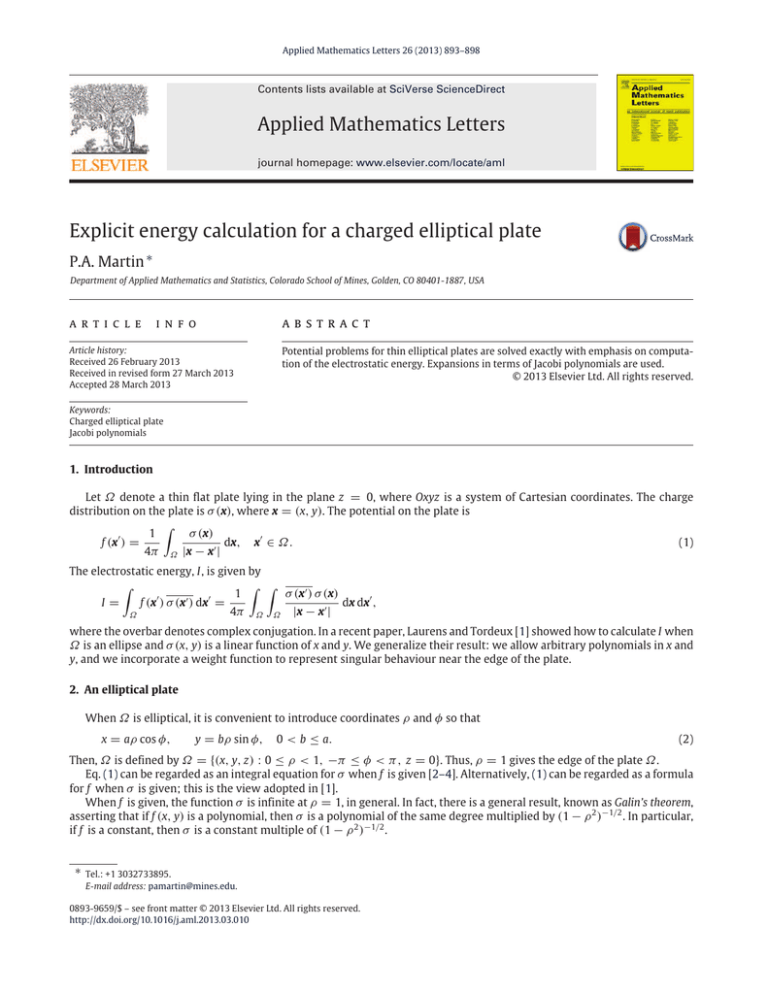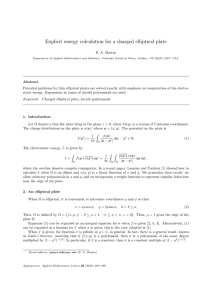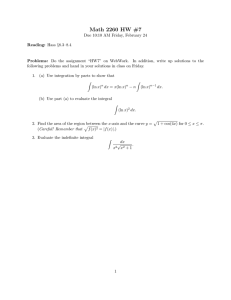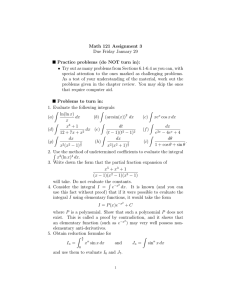
Applied Mathematics Letters 26 (2013) 893–898
Contents lists available at SciVerse ScienceDirect
Applied Mathematics Letters
journal homepage: www.elsevier.com/locate/aml
Explicit energy calculation for a charged elliptical plate
P.A. Martin ∗
Department of Applied Mathematics and Statistics, Colorado School of Mines, Golden, CO 80401-1887, USA
article
abstract
info
Article history:
Received 26 February 2013
Received in revised form 27 March 2013
Accepted 28 March 2013
Potential problems for thin elliptical plates are solved exactly with emphasis on computation of the electrostatic energy. Expansions in terms of Jacobi polynomials are used.
© 2013 Elsevier Ltd. All rights reserved.
Keywords:
Charged elliptical plate
Jacobi polynomials
1. Introduction
Let Ω denote a thin flat plate lying in the plane z = 0, where Oxyz is a system of Cartesian coordinates. The charge
distribution on the plate is σ (x), where x = (x, y). The potential on the plate is
f (x′ ) =
1
4π
Z
Ω
σ (x)
dx,
|x − x′ |
x′ ∈ Ω .
(1)
The electrostatic energy, I, is given by
I =
Z
Ω
f (x′ ) σ (x′ ) dx′ =
1
4π
Z Z
Ω
Ω
σ (x′ ) σ (x)
dx dx′ ,
|x − x′ |
where the overbar denotes complex conjugation. In a recent paper, Laurens and Tordeux [1] showed how to calculate I when
Ω is an ellipse and σ (x, y) is a linear function of x and y. We generalize their result: we allow arbitrary polynomials in x and
y, and we incorporate a weight function to represent singular behaviour near the edge of the plate.
2. An elliptical plate
When Ω is elliptical, it is convenient to introduce coordinates ρ and φ so that
x = aρ cos φ,
y = bρ sin φ,
0 < b ≤ a.
(2)
Then, Ω is defined by Ω = {(x, y, z ) : 0 ≤ ρ < 1, −π ≤ φ < π , z = 0}. Thus, ρ = 1 gives the edge of the plate Ω .
Eq. (1) can be regarded as an integral equation for σ when f is given [2–4]. Alternatively, (1) can be regarded as a formula
for f when σ is given; this is the view adopted in [1].
When f is given, the function σ is infinite at ρ = 1, in general. In fact, there is a general result, known as Galin’s theorem,
asserting that if f (x, y) is a polynomial, then σ is a polynomial of the same degree multiplied by (1 − ρ 2 )−1/2 . In particular,
if f is a constant, then σ is a constant multiple of (1 − ρ 2 )−1/2 .
∗
Tel.: +1 3032733895.
E-mail address: pamartin@mines.edu.
0893-9659/$ – see front matter © 2013 Elsevier Ltd. All rights reserved.
http://dx.doi.org/10.1016/j.aml.2013.03.010
894
P.A. Martin / Applied Mathematics Letters 26 (2013) 893–898
3. Fourier transforms
We start with a standard Fourier integral representation,
1
|x − x′ |
∞
Z
1
=
2π
−∞
Z
∞
−∞
|ξ|−1 exp{iξ · (x − x′ )} dξ,
where ξ = (ξ , η). Henceforth, we write
f (x′ ) =
1
4π
and
I =
where
1
2
ZZ
U (ξ) =
ZZ
RR
when the integration limits are as in (3). Thus
|ξ|−1 U (ξ) exp(−iξ · x′ ) dξ
(4)
|ξ|−1 |U (ξ)|2 dξ,
1
2π
Z
Ω
(3)
(5)
σ (x) exp(iξ · x) dx.
(6)
For an elliptical plate, we write the Fourier-transform variable ξ as
ξ = (λ/a) cos ψ and η = (λ/b) sin ψ.
Then, using (2), ξ · x = λρ cos(φ − ψ). Hence,
exp(iξ · x) =
∞
X
n =0
ǫn in Jn (λρ) cos n(φ − ψ),
where Jn is a Bessel function, ǫ0 = 1 and ǫn = 2 for n ≥ 1.
In order to evaluate U (ξ), defined by (6), we suppose that σ has a Fourier expansion,
σ (x) =
∞
X
m =0
σm (ρ) cos mφ +
∞
X
σ̃m (ρ) sin mφ.
(7)
m=1
Then, using dx = abρ dρ dφ and defining
Sn [gn ; λ] =
we obtain
U (ξ) = ab
Z
1
gn (ρ)Jn (λρ) ρ dρ,
∞
X
n =0
in Sn [σn ; λ] cos nψ + ab
−1
We have dξ = (ab)
ellipse.
From (4), we obtain
f (x) = f0 (ρ) + 2
where
fn (ρ) =
∞
b X
2π
(8)
0
m=0
∞
X
n =1
in Sn [σ̃n ; λ] sin nψ.
λ dλ dψ and |ξ| = (λ/b)(1 − k2 cos2 ψ)1/2 , where k2 = 1 − (b/a)2 ; k is the eccentricity of the
∞ n
X
n=1
c
Imn
(k)
fn (ρ) cos nφ + f˜n (ρ) sin nφ
Z
0
∞
Jn (λρ) Sm [σm ; λ] dλ,
Z ∞
∞
X
s
˜fn (ρ) = b
Imn (k)
Jn (λρ) Sm [σ̃m ; λ] dλ,
2π m=1
0
Z π
cos mψ cos nψ
c
m
n
p
dψ,
Imn (k) = i (−i)
1 − k2 cos2 ψ
0
Z π
sin mψ sin nψ
s
m
n
p
Imn (k) = i (−i)
dψ
1 − k2 cos2 ψ
0
o
(9)
(10)
(11)
(12)
P.A. Martin / Applied Mathematics Letters 26 (2013) 893–898
895
c
s
and we have noticed that |ξ| is an even function of ψ . The integrals Imn
and Imn
can be reduced to combinations of complete
elliptic integrals, K (k) and E (k). They are zero unless m and n are both even or both odd. (See [5, p. 276] for a discussion of
similar integrals.) Explicit formulae for a few of these integrals will be given later.
For the energy, I, (5) gives
1
I =
2a
= ab2
Z
∞
Z
π
−π
0
∞ X
∞
X
|U (ξ)|2 p
c
Imn
( k)
m=0 n=0
Z
dψ dλ
1 − k2 cos2 ψ
∞
0
Sm [σm ; λ] Sn [σn ; λ] dλ + ab2
∞ X
∞
X
m=1 n=1
s
Imn
(k)
Z
0
∞
Sm [σ̃m ; λ] Sn [σ̃n ; λ] dλ.
(13)
4. Polynomial expansions
To make further progress, we must be able to evaluate Sn [gn ; λ], defined by (8). We do this by expanding gn (ρ) using the
functions
(n,ν)
Gj
(ρ) = ρ n (1 − ρ 2 )ν Pj(n,ν) (1 − 2ρ 2 ),
(n,ν)
where Pj
(n,0)
is a Jacobi polynomial. The parameter ν controls the behaviour near the edge of the ellipse, ρ = 1. Thus, when
(ρ) is a polynomial; this covers the case discussed in [1]. Setting ν = − 12 gives appropriate expansion functions
(n,0)
when the goal is to solve (1) for σ . We note that Boyd [6, Section 18.5.1] has advocated using the polynomials Gj
(r ) as
radial basis functions in spectral methods for problems posed on a disc, 0 ≤ r < 1.
ν = 0, Gj
(n,ν)
The functions Gj
are orthogonal. To see this, note that Jacobi polynomials satisfy
1
Z
−1
(α,β)
(1 − x)α (1 + x)β Pi
(α,β)
(x)Pj
(x) dx = hi (α, β)δij ,
where hi is known and δij is the Kronecker delta; see [7, Section 18.3]. Hence, the substitution x = 1 − 2ρ 2 gives
Z
1
(n,ν)
Gi
0
(ρ)G(j n,ν) (ρ)
ρ dρ
= 2−n−ν−2 hi (n, ν)δij .
(1 − ρ 2 )ν
(n,ν)
Next, we use Tranter’s integral [8,9] to evaluate Sn [Gj
Z
1
0
(n,ν)
Jn (λρ)Gj
(ρ) ρ dρ =
Thus, if we write
σn (ρ) =
2ν
λν+1 j!
j! snj
X
2ν Γ (ν + j + 1)
j =0
; λ]:
Γ (ν + j + 1)J2j+n+ν+1 (λ).
(n,ν)
Gj
(14)
(ρ),
(15)
where snj are coefficients, we find that
Sn [σn ; λ] =
X snj
j =0
λν+1
J2j+n+ν+1 (λ).
(16)
We also expand σ̃n (ρ) as (15) but with coefficients s̃nj .
If we substitute (16) in (9), we encounter Weber–Schafheitlin integrals; these can be evaluated. We give a simple example
later.
If we substitute (16) in (13), we encounter integrals of the type
Z
∞
0
λ−2µ Jp+µ (λ)Jq+µ (λ) dλ
(17)
where µ = ν + 1, and p and q are non-negative integers. The integral (17) is known as the critical case of the Weber–
Schafheitlin integral; its value is [7, Eq. 10.22.57]
!
Γ 21 [p + q + 1] Γ (2µ)
!
!
.
!
22µ Γ 21 [2µ + p − q + 1] Γ 12 [2µ + q − p + 1] Γ 12 [4µ + p + q + 1]
(18)
896
P.A. Martin / Applied Mathematics Letters 26 (2013) 893–898
5. Three examples
We discuss three examples. In the first, we examine the dependence on the parameter ν but, for simplicity, we ignore
any dependence on the angle φ . In the second example, we compare with some results of Roy and Sabina [2] for ν = − 12 .
In the third example, we assume that σ (x, y) is a general quadratic function of x and y (so that ν = 0); this extends the
calculations in [1], where σ was taken as a linear function.
5.1. Example: dependence on ν
(n,ν)
For a very simple example, suppose that σ (x) = (1 − ρ 2 )ν for some ν > −1. Thus, as P0
= 1, (15) gives s00 = 2ν
0 −ν−1
n
n
Jν+1 (λ). Hence
Γ (ν + 1). All other coefficients sj and s̃j are zero. Then, from (16), S0 [σ0 ; λ] = s0 λ
f (x) = f0 (ρ) =
bs00
2π
c
I00
( k)
From (11), we obtain
c
I00
=2
Z
π /2
0
dx
∆
Z
∞
λ−ν−1 J0 (λρ)Jν+1 (λ) dλ,
0
0 ≤ ρ < 1.
(19)
= 2K (k),
(20)
where ∆ = (1 − k2 sin2 x)1/2 . From [7, Eq. 10.22.56], the integral in (19) evaluates to
√
π
1
1
2
!
F
,
,
−
ν
−
;
1
;
ρ
2
2
2ν+1 Γ ν + 23
where F is the Gauss hypergeometric function. Hence
f (x) =
b
2π
K (k)
√
π Γ (ν + 1)
!
F
Γ ν + 32
1
2
1
, − ν − ; 1; ρ 2 ,
2
0 ≤ ρ < 1.
When ν = − 21 , F ( 21 , 0; 1; ρ 2 ) = 1 and f (x) = 12 bK (k), a constant, in accord with Galin’s theorem.
When ν = 0, we obtain f (x) = (2b/π 2 )K (k)E (ρ) for 0 ≤ ρ < 1, using [7, Eq. 19.5.2]. Thus, for this particular f , the
solution of the integral equation (1) is σ = 1. Although this solution is bounded, we see that adding a small constant to f
adds a constant multiple of (1 − ρ 2 )−1/2 to σ . In other words, the integral equation (1) has bounded solutions for some f ,
but these solutions are not typical: singular behaviour around the edge of Ω should be expected.
5.2. Example: comparison with Roy and Sabina
Roy and Sabina [2] consider σ (x) = (1 − ρ 2 )−1/2 g (x, y) when g (x, y) is a quadratic in x and y.√As a particular example, let
us take g (x, y) = 4π x = 4π aρ cos φ . Thus, n = 1, ν = − 12 and j = 0 in (15), giving s10 = 4π a π /2; all other coefficients
snj are zero. Then, from (16), S1 [σ1 ; λ] = s10 λ−1/2 J3/2 (λ). Hence
f (x) = 2f1 (ρ) cos φ =
bs10
π
c
I11
(k) cos φ
Z
0
∞
dλ
J1 (λρ)J3/2 (λ) √ ,
λ
0 ≤ ρ < 1.
c
It is shown in Section 5.3 that I11
(k) = 2(K − E )/k2 . From [7, Eq. 10.22.56], the integral in (21) evaluates to 12 ρ
c
f (x) = π bxI11 , in agreement with [2, Eq. (14b)].
(21)
√
π /2. Hence
5.3. Example: quadratic σ
Suppose that
σ (x) = α0 + α1 (x/a) + α2 (y/b) + 2α3 (x/a)2 + 2α4 (xy)/(ab) + 2α5 (y/b)2
= {α0 + ρ 2 (α3 + α5 )} + α1 ρ cos φ + α2 ρ sin φ + (α3 − α5 )ρ 2 cos 2φ + α4 ρ 2 sin 2φ,
with constants αj ; Laurens and Tordeux [1] have α3 = α4 = α5 = 0. Then (7) gives
σ0 (ρ) = α0 + (α3 + α5 )ρ 2 ,
(22)
2
2
σ1 = α1 ρ, σ̃1 = α2 ρ, σ2 = (α3 − α5 )ρ and σ̃2 = α4 ρ . All other terms in (7) are absent.
(n,ν)
Next, we use P0
= 1 and ν = 0. These give s10 = α1 , s̃10 = α2 , s20 = α3 − α5 and s̃20 = α4 . For s0j , we use P1(0,0) (x) =
P1 (x) = x, giving
σ0 (ρ) = s00 G(00,0) + s01 G(10,0) = s00 + s01 (1 − 2ρ 2 ).
P.A. Martin / Applied Mathematics Letters 26 (2013) 893–898
897
Comparison with (22) gives α0 = s00 + s01 and α3 + α5 = −2s01 ; these determine s00 and s01 . Apart from the six mentioned, all
other coefficients snj and s̃nj are zero.
Then, from (16), we obtain
λS0 [σ0 ; λ] = s00 J1 (λ) + s01 J3 (λ),
λS1 [σ1 ; λ] = s10 J2 (λ),
λS1 [σ̃1 ; λ] = s̃10 J2 (λ),
λS2 [σ2 ; λ] = s20 J3 (λ),
λS2 [σ̃2 ; λ] = s̃20 J3 (λ).
We use these to compute the energy, I, given by (13). We will need the integrals (see (18))
Jpq =
∞
Z
1
Jp+1 (λ)Jq+1 (λ) dλ
λ2
0
!
Γ 12 [p + q + 1]
!
!
.
=
4 Γ 2 [3 + p − q] Γ 21 [3 + q − p] Γ 12 [5 + p + q]
!1
Thus
I
Z
∞
2
∞
Z
2
Z
(23)
∞
|S0 [σ0 ; λ]| dλ +
|S1 [σ1 ; λ]| dλ +
|S2 [σ2 ; λ]|2 dλ
ab2
0
0
0
Z ∞
Z ∞
Z ∞
2
c
s
s
|S1 [σ̃1 ; λ]| dλ + I22
|S2 [σ̃2 ; λ]|2 dλ
+ 2I02 Re
S0 [σ0 ; λ] S2 [σ2 ; λ] dλ + I11
0
0
0
o
n 2
c
s0 J00 + 2 Re s0 s0 J02 + s0 2 J22 + I c s1 2 J11
= I00
0 1
0
11 0
1
c 2 2
s 2 2
s 1 2
c
+ I22
s̃0 J22 .
s̃0 J11 + I22
s0 J22 + 2I02
Re s00 s20 J02 + s01 s20 J22 + I11
=
c
I00
c
I11
c
I22
(24)
From (23), we obtain
J00 =
4
3π
J11 =
,
4
15π
J22 =
,
4
35π
4
J02 =
,
45π
.
c
c
c
s
c
s
= 2K (k) (see (20)), Imm
For Imn
and Imn
, we have I00
,
+ Imm
= I00
s
c
c
I11
− I11
= I02
=2
c
I22
−
s
I22
=2
2
Z
π /2
Z
π /2
∆
0
cos 4x
∆
0
cos 2x
dx =
2
dx =
32k′
3k4
k2
2
K + 2K +
where k′ = 1 − k2 = (b/a)2 . Thus
c
I11
= 2(K − E )/k2 ,
2
(k2 − 2)K (k) +
16
3k4
4
k2
E (k),
(k2 − 2)E ,
2
s
I11
= 2(E − k′ K )/k2 ,
c
I22
= 2{(3k4 + 8k′ )K + 4(k2 − 2)E }/(3k4 ),
2
s
I22
= 8{(2 − k2 )E − 2k′ K }/(3k4 ).
One can check that these all have the correct limiting values as k → 0.
This completes the computation of all the quantities required in (24). In the special case considered by Laurens and
Tordeux [1], we have s00 = α0 , s10 = α1 , s̃10 = α2 and s01 = s20 = s̃20 = 0, whence
c
c
s
I /(ab2 ) = |α0 |2 I00
J00 + |α1 |2 I11
J11 + |α2 |2 I11
J11
=
8
15π
(
2K −E
5|α0 |2 K + |α1 |
k2
2
′
2E −k K
+ |α2 |
k2
,
)
in agreement with [1, Theorem 1.1].
6. Discussion
The (weakly singular) integral equation (1) arises when Laplace’s equation holds in the three-dimensional region exterior
to a thin flat plate Ω with Dirichlet boundary conditions on both sides of Ω . There are analogous (hypersingular) integral
equations when a Neumann boundary condition is imposed. Explicit formulae for σ in terms of f are known when Ω is
circular; for a review, see [10].
Expansion methods of the kind used above for problems involving elliptical plates, screens or cracks have a long history.
The author’s 1986 paper [5] gives references for Neumann problems, in the context of crack problems. For Dirichlet problems,
898
P.A. Martin / Applied Mathematics Letters 26 (2013) 893–898
see [2–4]. Similar expansion methods have been used recently for the problem of internal wave generation in a continuously
stratified fluid by an oscillating elliptical plate [11].
References
[1]
[2]
[3]
[4]
[5]
[6]
[7]
[8]
[9]
[10]
[11]
S. Laurens, S. Tordeux, Explicit computation of the electrostatic energy for an elliptical charged disc, Appl. Math. Lett. 26 (2013) 301–305.
A. Roy, F.J. Sabina, Low-frequency acoustic diffraction by a soft elliptic disk, J. Acoust. Soc. Am. 73 (1983) 1494–1498.
A.K. Gautesen, F.J. Sabina, On the problem of the electrified elliptic disk, Quart. J. Mech. Appl. Math. 43 (1990) 363–372.
J. Boersma, E. Danicki, On the solution of an integral equation arising in potential problems for circular and elliptic disks, SIAM J. Appl. Math. 53 (1993)
931–941.
P.A. Martin, Orthogonal polynomial solutions for pressurized elliptical cracks, Quart. J. Mech. Appl. Math. 39 (1986) 269–287.
J.P. Boyd, Chebyshev and Fourier Spectral Methods, second ed., Dover, New York, 2001.
NIST Digital Library of Mathematical Functions, Release 1.0.5 of 2012-10-01. http://dlmf.nist.gov/.
C.J. Tranter, Integral Transforms in Mathematical Physics, third ed., Methuen, London, 1966.
S. Krenk, Some integral relations of Hankel transform type and applications to elasticity theory, Integral Equations Operator Theory 5 (1982) 548–561.
P.A. Martin, Exact solution of some integral equations over a circular disc, J. Integral Equations Appl. 18 (2006) 39–58.
P.A. Martin, S.G. Llewellyn Smith, Generation of internal gravity waves by an oscillating horizontal elliptical plate, SIAM J. Appl. Math. 72 (2012)
725–739.






